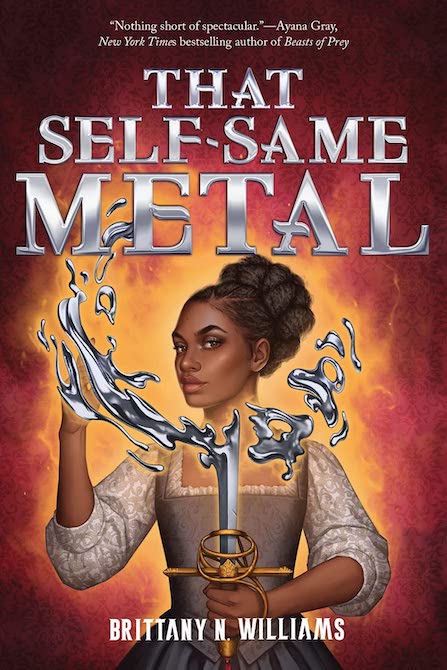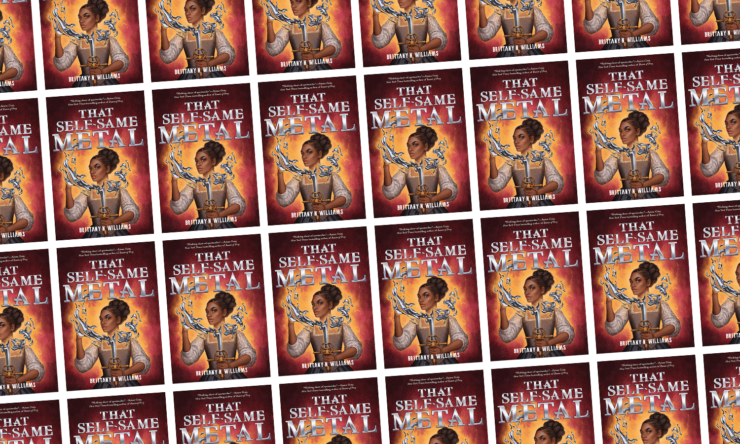Brittany N. Williams’s debut novel, That Self-Same Metal, is one book you can judge by its cover. The compelling image gets across all the central reasons to read this young adult historical fantasy: a confident and dynamic Black heroine in a Jacobean brocade dress, who is either forming a sword from liquid quicksilver or dissolving it. Cap this off with a title taken from King Lear, and it is clear what fun awaits the curious reader.
Our magic-wielding protagonist is Joan Sands, the sixteen-year old fight director and weapons mistress for the King’s Men—a troupe of actors led by none other than William Shakespeare. Joan is well-suited for keeping stage blades shiny but safely blunt, as she is a spiritual child of Ogun, the Orisha with power over metal. Her twin brother James (a child of Oya, Orisha of wind and death) is a member of the company too, playing the young female roles since in 1605, it is illegal for women to do the lewd work of acting. The two siblings are not the only magical ones in this group, either. One master actor is Fae and, like all fair folk, carries the telltale glow of his heritage, though these auras can be seen only by the children of the Orisha.
Buy the Book


That Self Same Metal
While preparing for a performance at Whitehall Palace, Joan runs into her godfather and mentor Baba Ben, the only other child of Ogun in London. He explains that the new King James has neglected to maintain an important pact that keeps the more bloodthirsty Fae from harming humans, and that he has come to the palace to perform this Pact’s ritual. No sooner does Joan learn of this crucial business than guards appear to arrest Baba Ben. As Joan hides, one guard stays back to gloat, and reveals herself as a shapeshifter who somehow doesn’t glow like other Fae. Without Ben to renew the Pact, the Fae are newly freed to wreak havoc all over the city.
Cue murderous creatures of Faerie, from kelpies to red-caps to bone-crunching hags! Cue Ogun possessing Joan to fight Auberon himself! Cue Joan realizing that her power over iron might be the only way to stop the Fae from devouring any human they like!
This vivid scene and all the players set, Williams’s fast-paced adventure gallops apace to the final page. With only a few beats of stillness and reflection at Joan’s home with her parents, the structure of the novel put me in mind of a videogame. Each battle is greater and more terrifying than the one before, as Joan learns on the fly to use her powers to defend the people of London. Interludes act as cut scenes depicting the deadly deeds inflicted upon humans by the amoral Fae. When the climactic sequence comes, it is not only a boss battle but a crackling explosion of everything set in motion over the past 250 pages.
While That Self-Same Metal may have a modern sense of pace, it has a Shakespearean sense of texture. From chapter titles to scraps of dialogue to names of powerful Fae, regular references to the Bard’s oeuvre are treats for nerds (like me) who will recognize them. Williams also includes critiques of Shakespeare’s work that will be familiar to any contemporary lover of the playwright: the racism of Othello, the sexual predation and misogyny in Measure for Measure. As a character, William Shakespeare himself is charming and infuriating by turns—and plays a surprisingly pivotal role.
Williams’s mash-up of Restoration theatre, Celtic-inflected faeries, and Orisha tradition is clever. Yet what struck me most is that Joan’s story is powered by ideals of mutual aid and vulnerable communities banding together. Joan and her brother come to the defense of sex workers; religious minorities watch out for each other; the King’s Men rally around Joan when her life and family are threatened. Williams deftly depicts the strange class position artists occupy as financially insolvent craftspeople who are in regular company with wealthy elites, and she acutely portrays the hellish compromises for survival demanded of Black and queer people by those elites.
These are powerful themes for a young adult novel, and it elevates this one above its use of conventional elements of the genre. Joan is a sort of chosen one, and she is in an oddly tepid love triangle (although her bisexuality is refreshing.) She must accept her inner strength to master her magic, and the twist at the end seems reliant on Joan forgetting some crucial information. That said, these are reliable trappings of YA literature for good reason. If That Self-Same Metal leans on them a little much, Williams makes up for it with her thoughtful inventiveness.
My few reservations aside, I’d sum it up this way: if the sequel were done, then ‘twere well it were done quickly, because once immersed in the world of Joan Sands, you’re not going to want to leave.
That Self Same Metal is published by Amulet Books.
Read an excerpt here.
Maura Krause is a writer and Barrymore-nominated theatrical director, currently pursuing their MFA in Writing at California College for the Arts.










